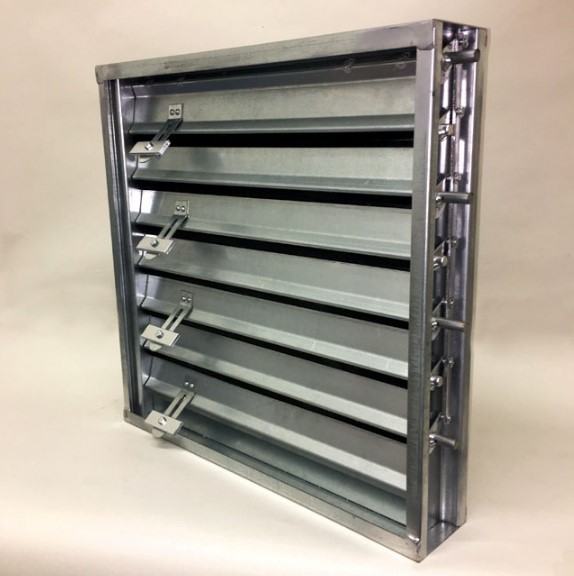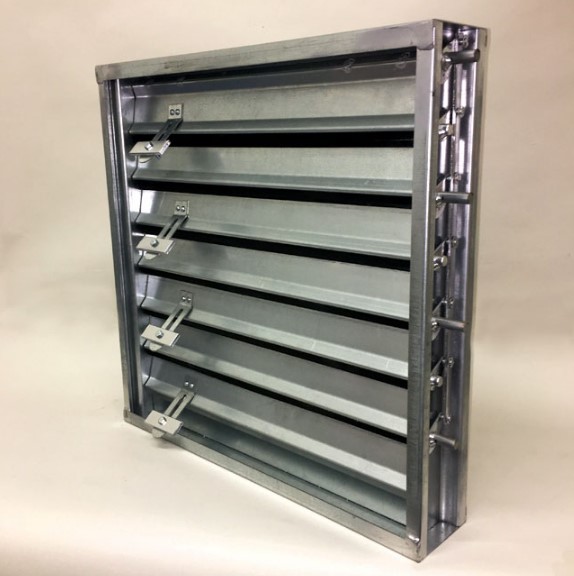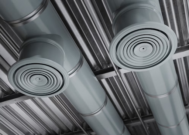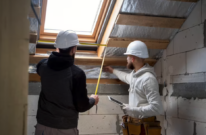Backdraft Dampers Buyers Guide for 2023


Brian Jeffries
Brian Jeffries, a seasoned BPA Advisor. Brian is dedicated to sharing his wealth of knowledge on construction projects and materials. With a focus on architecture and building envelopes, Brian contributes valuable insights that shape the discourse around innovative construction practices and materials.
Whether it's a home or any enclosed space, they have a way of spreading and sharing germs. It's not just germs that become an issue; dust, bacteria, dander, pollen, and other harmful things tend to spread throughout the home or other shared spaces. When it comes to allergens such as dander or pollen, they can wreak havoc in a home. If a home isn't properly ventilated, then this is only going to exacerbate the issues of allergies for the residents.
It's far from ideal, which is why clean air needs to circulate in a home, especially if there is a lack of proper ventilation. Quality air brings quality life; this extends to good health and comfort. So when it comes to keeping the air well-ventilated, circulated, and keeping your loved ones happy and healthy, having a backdraft damper can help with this significantly. So if you're wondering where to get started, we're here to help. Here is your backdraft dampers buyers guide to answer all of your questions!

What Backdraft Dampers Are?
So, what are backdraft dampers? Do they dampen the air? Also known as "gravity dampers," these allow airflow to go in one direction. This helps prevent reverse airflow, such as what's in the exhaust of the HVAC. When it comes to backdraft dampers can either be operated by gravity or through motorization. The backdraft damper helps ensure the overall function of the ventilation system; it's what's needed to make sure that the job gets done correctly. Without the backdraft damper, your home will have awful odors, more bacteria, and allergens, and it will make the air quality fairly poor.
How Do Backdraft Dampers Work?
As stated above, backdraft dampers are meant to help with ventilation within a home (or even a business). Air flowers out of its gravity, as this is the only source where the backdraft damper closes. This means that contaminated air can't come back in, so it's not going to circulate the air within the space. It's often used on exhaust systems for HVACs, heat exchangers, solar heating systems, and others.
There's no leakage, making it safe for your home's environment. So, each blade axle runs through one side of its blade. Whenever the blades rotate, they will act as a flap. When this happens, the air is pushed inside, and the dampers close, keeping the air and its contents inside.
Backdraft Dampers Applications
So, where are backdraft dampers usually applied? The two most appropriate spaces for backdraft dampers would be residential and commercial spaces. They're essentially needed in enclosed spaces where people gather together. Let's take a look closer at these two applications.
Residential Use
When it comes to residential backdraft dampers, you're mostly going to hind them in dryer vents, pantry hoods, HVAC stems, and the bathroom exhaust system. The whole goal is to provide better air ventilation for the home; overall, this is meant to remove pollutants from staying in your home, which is a major health risk. This is especially apparent if you have family members with asthma or allergies, as poor air quality in the home is going to make their conditions far worse. Even during bad weather, such as wind storms, it helps prevent any debris from entering your home. Overall, you can say that this is a worthwhile investment.
Commercial and Industrial Use
Just as backdraft dampers can be used for residential purposes, they can also be used for commercial purposes too. In terms of commercial purposes, the damper will act as both a gravity damper as well as a control damper. If in use as a gravity damper, the airflow will keep in one direction, while the control damper will prevent air from running backwards. In terms of backdraft dampers for commercial and industrial use, there is a counterbalancing with weight to help adjust the pressure of air control.
There are motor blades included in commercial backdrafts too, and this help keep the dampers open (and closed) without needing air pressure. It's going to be the adjustable weight that helps with the pressure instead. Other than the adjustable weight and blades, is there anything else that's included in commercial and industrial backdraft dampers that may not be included for residential backdraft dampers? Absolutely, commercial backdraft dampers and residential ones are not created equally; here are some accessories that you can expect to find:
- Barometric Relief Damper: Used for low-velocity systems such as stairwells
- Fan Accessory Industrial Backdraft Damper: This is primarily recommended for areas with a low temperature
- Relief Damper: The main focus is to help keep a constant airflow
Types of Backdraft Dampers

When it comes to dampers, there aren't only the applications (residential and commercial) that need to be put into consideration, but there are different types of backdraft dampers too. Each of these brings something unique to the table. So let's look at some of the backdraft dampers you'll come across when you're shopping for the perfect backdraft damper for your property.
Gravity-operated dampers
This is one of the more well-known dampers in the market. This helps keep the airflow coming in one direction and won't allow it to come from the opposite direction. You can expect some of the following features with Gravity-operated dampers:
- Back pressure requirements
- Mounting configuration (such as for ducts)
- Start-open pressure
- Controlled airflow direction
Spring-loaded dampers
Up next, we have spring-loaded dampers; these have springs in order to assist with opening up the damper blades. This helps with opening and closing the damper blades.
Motorized dampers
The motorized dampers are pretty similar to the traditional gravity dampers. However, one of the only major differences (except for motorization) would be the fact that these tend to be used for commercial purposes. In contrast, standard gravity dampers can be used for both residential and commercial purposes.
Butterfly dampers
The main focus for butterfly dampers would be its focus on cutting back on energy use. It's primarily used for heat exhaust systems such as solar heating systems and will oftentimes be made out of galvanized steel.
Blade dampers
These are often referred to as "rectangular dampers" and are usually based on the blade action. The parallel blade dampers are used for opening and closing and offer better airflow control by the operating range. There is another type of blade damper called Opposed blades, and these offer excellent airflow control throughout the entire operating range.
Inflatable dampers
These can be great for preventing overheating and overcooling. The installation is known for being easier compared to the other systems, but this can only go into HVAC ducts and nowhere else.
How to Choose the Right Backdraft Dampers?
You're going to need a keen eye when it comes to selecting the right damper for your property. It's so important to know exactly what you're looking for, as every type of damper is different. For starters, do you have the right HVAC equipment? Do you know where you want this to be installed? In order to understand your needs and which damper you should pick, you should first start out by looking into these factors.
Application
Are you needing this in a residential application such as a house or a commercial space such as a warehouse? This is going to be the easiest part when it comes to choosing the right backdraft, as different types will either suit commercial or residential needs. This will help you narrow it down.
Airflow direction
The airflow is another incredibly important factor that needs to be kept in mind. Why? If the damper is installed incorrectly, it may not function properly and could cause issues with the ventilation system. So you'll need to look where the airflow direction is, as well as where you want this installed (such as a bathroom vent, top stove ventilation, HVAC, etc..)
Pressure differences
Pressure differences can also impact the performance of a backdraft damper. High-pressure differences can cause the damper to close too quickly, while low-pressure differences may not provide enough force to close the damper. This is something that commercial spaces will need to be on the lookout for rather than residential property owners.
Damper type
There are several types of backdraft dampers to choose from. As we discussed earlier, each type has its own advantages and disadvantages, So you can't just easily pick one it. Instead, you need to consider your specific needs and the ventilation system that you have.
Size and dimensions
You'll need to consider the size and dimensions of your space as well as the size and dimensions of the backdraft damper too. Choosing the wrong size can impact the performance of the ventilation system and cause issues with airflow.
Material
When you're shopping for a damper, you're going to need to be sure that you're picking one that can last for years on end; it needs to be able to handle the conditions that it's going to be exposed to. Make sure to look into materials such as galvanized steel, stainless steel, and aluminum.
Installation and maintenance
It's strongly recommended that you have a professional do the installation and the maintenance for dampers; it's not something that should be seen as a DIY project. There's always the chance for mistakes, and you're risking poor air quality when doing so.
Energy efficiency
Being eco-friendly is vital, so make sure to look for dampers that have a low-pressure drop and a tight seal to minimize energy loss.
Cost
Finally, the cost is an important factor to consider when choosing a backdraft damper. While it may be tempting to choose a cheaper option, investing in a high-quality backdraft damper can save money in the long run by improving the efficiency of the ventilation system and reducing maintenance costs.
Take Control of Your Ventilation System with the Right Backdraft Damper
Investing in a high-quality backdraft damper is crucial to ensure optimal indoor air quality and energy efficiency for both homes and businesses. Essentially, everyone needs clean air, especially those with allergies and asthma. While it can feel a tad overwhelming to know which one is the right one for your project (especially what's on the market), it's important to pick one that fits your needs while keeping everyone healthy.
By considering factors such as size, airflow rating, and material quality, you can narrow down your choices and make an informed decision. Whether you're a homeowner, HVAC professional, or facility manager, purchasing the right backdraft damper can help you achieve a healthier, more comfortable, and cost-effective indoor environment.
Get Smarter About Building Products
Join 50,000+ subscribers and get our 3 min daily newsletter on what matters in the building materials industry.
You might like this


Solving Ventilation Challenges: Metal Deck Profiles and Back Draft Dampers as Key Solutions
When it comes to building design and construction, ventilation is a critical factor that often presents significant challenges. Proper ventilation is essential for maintaining indoor air quality, controlling temperature, and ensuring occupant comfort and safety. In this article, we will explore how metal deck profiles and back draft dampers are key solutions for addressing ventilation […]


The Ultimate Guide to Home Insulation
When it comes to creating a comfortable and energy-efficient home, insulation plays a pivotal role. Proper insulation helps regulate indoor temperatures, reduces energy consumption, and enhances overall comfort. In this comprehensive guide, we’ll explore various aspects of home insulation, including the best types of insulation for different areas of your home and key considerations for […]


The Best Hidden Deck Fasteners: Concealed Elegance and Lasting Stability
Decks, those quintessential outdoor havens, serve as extensions of our living spaces, inviting us to bask in the open air. But what if we could take this experience to the next level? Enter concealed deck fasteners, the unsung heroes that elevate your deck’s appearance and structural integrity, all while keeping their existence a secret. In […]